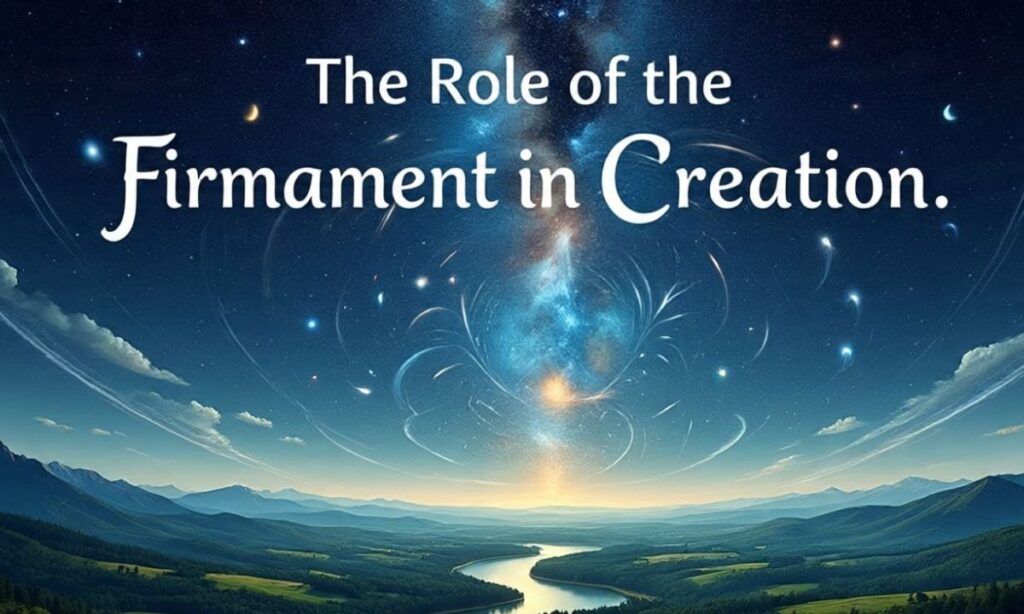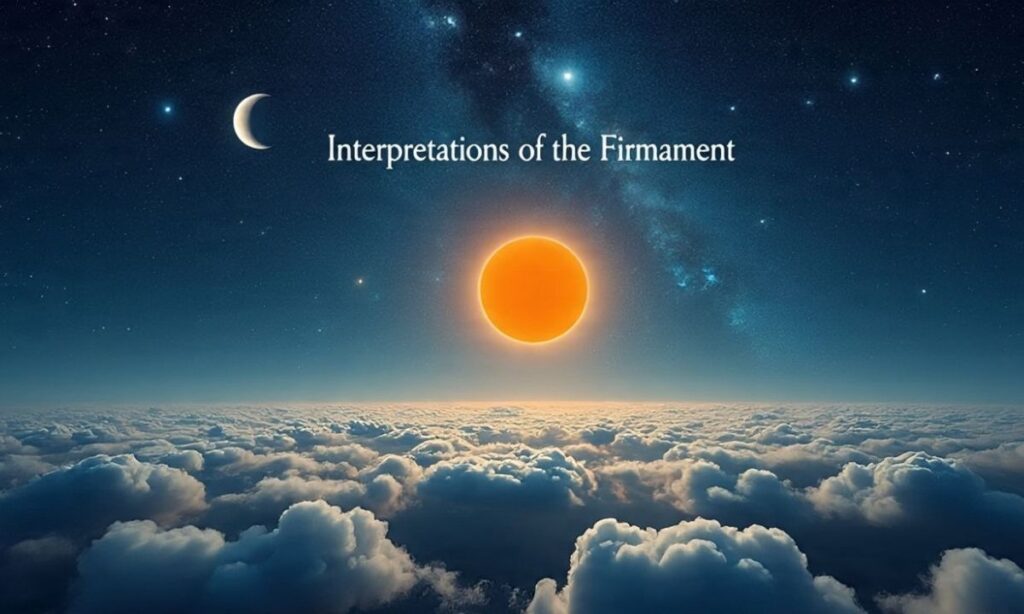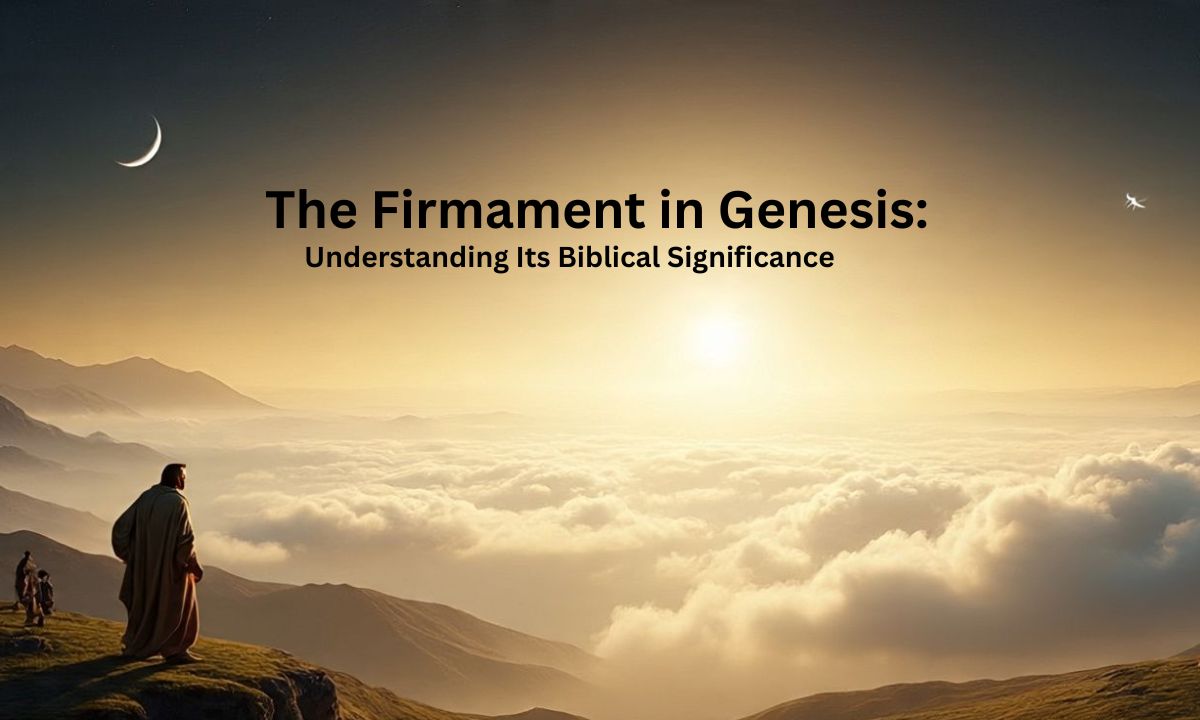The firmament in Genesis is an important part of the creation story. God made it on the second day to separate the waters above from the waters below. The Bible says He called the firmament “Heaven.” This shows His power to bring order to the world.
Understanding the firmament helps us see God’s plan in creation. It was not only the sky but also a symbol of His design. Ancient people viewed it as a great dome above the earth. Today, it reminds us of God’s glory and the beauty of His creation.
What Is the Firmament?
The Hebrew word “raqia” translates to firmament in English. This term appears multiple times throughout Genesis 1. It literally means “something hammered out” or “expanse.” Ancient metalworkers would hammer metal into thin sheets. This process created the imagery behind the Hebrew concept.
The firmament represents a solid dome-like structure. Ancient peoples envisioned it spanning across the earth. This structure separated different regions of creation. It established boundaries between various elements. The firmament created distinct spaces within the cosmos.
Biblical scholars debate the exact nature of this structure. Some view it as purely metaphorical language. Others consider it a reflection of ancient cosmology. The firmament appears as both physical and spiritual reality. It serves multiple functions within the creation account.
Key Characteristics of the Firmament
The firmament possesses several distinct features:
- Expansive nature: It stretches across the heavens
- Separating function: It divides waters above from waters below
- Solid appearance: Ancient texts suggest a dome-like structure
- Divine origin: God personally creates this element
- Purposeful design: It serves specific functions in creation
The firmament demonstrates God’s organizational power. It transforms chaotic waters into ordered systems. This structure provides stability to the created world. The firmament establishes reliable patterns and cycles.
The Role of the Firmament in Creation

Genesis 1:6-8 details the firmament’s creation on the second day. God spoke this structure into existence. The firmament immediately began its separating work. It divided the primordial waters into distinct regions. This separation created space for life to flourish.
The firmament serves three primary functions in creation. Each function demonstrates God’s intentional design. These roles work together harmoniously. They establish the framework for all subsequent creation.
1. Division of Waters
The firmament’s primary function involves separating waters. Genesis describes waters above and below the firmament. This separation creates distinct atmospheric layers. It establishes weather patterns and precipitation cycles.
Ancient peoples observed water in various forms:
- Rain falling from above
- Seas and rivers on earth
- Morning dew appearing mysteriously
The firmament explained these phenomena. It provided a logical framework for understanding water’s behavior. This separation made land habitable for living creatures.
Water Distribution Table
| Location | Type of Water | Function |
| Above Firmament | Celestial waters | Source of rain and precipitation |
| Below Firmament | Terrestrial waters | Seas, rivers, and groundwater |
| Within Firmament | Atmospheric moisture | Clouds and weather systems |
The division creates a sophisticated water cycle. This system sustains all life on earth. The firmament regulates water distribution perfectly. It demonstrates divine wisdom in creation.
2. Called “Heaven”
God specifically names the firmament “Heaven” in Genesis 1:8. This designation carries profound theological significance. Heaven represents the dwelling place of divine beings. It symbolizes God’s realm above earthly concerns.
The naming establishes hierarchy in creation. Heaven sits above earth in both position and importance. This arrangement reflects spiritual realities. The firmament becomes a bridge between realms.
Levels of Heaven in Scripture
Biblical texts reference multiple heavens:
- First Heaven: The atmospheric realm where birds fly
- Second Heaven: The celestial realm containing stars and planets
- Third Heaven: The spiritual realm where God dwells
The firmament primarily represents the first heaven. It provides the physical boundary for the earthly atmosphere. This heaven contains weather patterns and flying creatures. Birds operate within this firmament space.
3. Foundation for Celestial Bodies
The fourth day of creation places celestial bodies in the firmament. Genesis 1:14-19 describes this process in detail. God sets the sun, moon, and stars within this structure. They serve as lights and timekeeping devices.
The firmament provides a stable platform for celestial objects. These bodies move according to divine design. They mark seasons, days, and years reliably. The firmament ensures their consistent operation.
Functions of Celestial Bodies
The celestial bodies serve multiple purposes:
- Illumination: Providing light for day and night
- Time measurement: Marking seasons and cycles
- Navigation: Guiding travelers and sailors
- Signs: Indicating divine messages and timing
- Beauty: Displaying God’s creative glory
These functions depend on the firmament’s stability. The structure supports their movements and positions. It maintains cosmic order and predictability.
Interpretations of the Firmament

Scholars and theologians offer various interpretations of the firmament. These perspectives reflect different approaches to biblical texts. Each interpretation addresses specific concerns and contexts. Understanding these views enriches our comprehension.
Ancient View
Ancient Near Eastern peoples shared common cosmological concepts. They envisioned a solid dome covering the earth. This dome held back celestial waters above. The firmament prevented these waters from flooding the earth.
Ancient texts from various cultures describe similar structures:
- Mesopotamian myths mention solid sky-domes
- Egyptian cosmology includes celestial boundaries
- Greek philosophy discusses crystalline spheres
The Hebrew concept fits within this broader understanding. It reflects the scientific knowledge of its time. Ancient peoples based their views on direct observation. They interpreted natural phenomena through available frameworks.
Ancient Cosmological Elements
| Element | Description | Function |
| Solid Dome | Crystalline or metallic barrier | Separates waters and supports celestial bodies |
| Pillars | Structural supports | Hold up the firmament |
| Windows | Openings in the dome | Allow rain to fall through |
| Foundations | Underground supports | Anchor the structure |
This worldview provided practical explanations for natural phenomena. It satisfied ancient peoples’ need to understand their environment. The firmament concept helped explain weather patterns and celestial movements.
Modern Perspective
Contemporary readers often struggle with ancient cosmology. Scientific understanding has dramatically evolved since biblical times. Modern astronomy reveals the true nature of space and atmosphere. This knowledge creates interpretive challenges.
Some modern approaches to the firmament include:
- Phenomenological interpretation: Understanding descriptions from human perspective
- Accommodating language: God using familiar concepts to communicate
- Literary device: Poetic language rather than scientific description
- Progressive revelation: Truth revealed according to human capacity
Modern believers seek to honor both scientific truth and biblical authority. They recognize the text’s ancient context while affirming its spiritual message. The firmament’s theological significance transcends its physical description.
Reconciling Ancient and Modern Views
Several strategies help bridge ancient and modern perspectives:
- Recognize genre: Genesis uses theological rather than scientific language
- Consider audience: The text addresses ancient peoples’ understanding
- Focus on purpose: Emphasis on God’s creative power rather than mechanics
- Appreciate metaphor: Physical descriptions convey spiritual truths
These approaches maintain biblical authority while acknowledging scientific discoveries. They preserve the firmament’s theological significance. The text continues to speak meaningfully to modern audiences.
Theological Interpretation
Theologians emphasize the firmament’s spiritual significance over its physical properties. They focus on what the text teaches about God and creation. The firmament reveals divine attributes and intentions.
Key theological themes include:
- Divine sovereignty: God controls and orders creation
- Intentional design: Every element serves specific purposes
- Boundary setting: God establishes limits and structures
- Providential care: The firmament enables life and flourishing
The firmament demonstrates God’s wisdom and power. It shows divine concern for creation’s welfare. This structure enables life to exist and thrive. The firmament reflects God’s loving provision.
The Firmament’s Spiritual Significance

Beyond its physical description, the firmament carries profound spiritual meaning. It represents the boundary between earthly and heavenly realms. This separation acknowledges different levels of reality. The firmament connects yet distinguishes these realms.
Symbol of Divine Authority
The firmament demonstrates God’s absolute authority over creation. By speaking it into existence, God shows sovereign power. This structure obeys divine command immediately. It maintains its function consistently throughout history.
The firmament’s reliability reflects God’s faithfulness. It operates according to divine design without fail. This consistency provides security for earthly life. Believers find comfort in God’s unchanging nature.
Bridge Between Realms
While separating heaven and earth, the firmament also connects them. It allows interaction between divine and human realms. God’s throne sits above the firmament yet remains accessible. Prayer and worship traverse this boundary.
The firmament permits divine intervention in earthly affairs. God acts within creation while remaining transcendent. This structure enables a relationship between Creator and creation. It facilitates communication and communion.
Foundation for Worship
The firmament’s beauty inspires worship and praise. Psalm 19:1 declares that the heavens proclaim God’s glory. The firmament displays divine craftsmanship daily. Its vastness evokes awe and reverence.
Believers throughout history have found spiritual meaning in the firmament. It reminds them of God’s greatness and creativity. The structure calls humanity to worship and thanksgiving. It demonstrates divine care and provision.
Biblical References to the Firmament
Scripture contains numerous references to the firmament beyond Genesis. These passages expand our understanding of its significance. They reveal different aspects of its nature and function.
Old Testament References
The Hebrew Bible mentions the firmament in various contexts:
- Psalm 19:1: “The heavens declare the glory of God; the firmament shows His handiwork”
- Psalm 150:1: “Praise God in His sanctuary; praise Him in His mighty firmament”
- Ezekiel 1:22: Describes a crystal-like firmament above the cherubim
- Ezekiel 10:1: References the firmament over the cherubim’s heads
- Daniel 12:3: Compares the wise to the brightness of the firmament
Each reference adds depth to our understanding. The firmament appears in prophetic visions and worship contexts. It serves as a symbol of divine glory and majesty.
Firmament in the Psalms
The Psalms frequently reference the firmament in worship contexts:
| Psalm | Reference | Theme |
| Psalm 19 | Heavens declare God’s glory | Divine revelation through creation |
| Psalm 150 | Praise in the firmament | Worship venue |
| Psalm 148 | Praise from the firmament | Universal praise |
These passages emphasize the firmament’s role in worship. It serves as both source of revelation and a venue for praise. The structure calls creation to acknowledge God’s greatness.
New Testament Connections
While the New Testament rarely uses firmament terminology, it contains related concepts. The “heavens” often refers to similar ideas. Paul’s reference to the “third heaven” connects to firmament concepts.
Revelation’s cosmic imagery draws on firmament symbolism. The crystal sea before God’s throne recalls Ezekiel’s firmament description. These connections maintain continuity between testaments.
Frequently Asked Questions
What does the firmament in Genesis mean?
The firmament in Genesis means the expanse God created to separate the waters above from the waters below.
Why did God create the firmament in Genesis?
God created the firmament in Genesis to bring order and structure to His creation.
Where is the firmament in Genesis mentioned?
The firmament in Genesis is mentioned in Genesis 1:6–8 during the second day of creation.
Is the firmament in Genesis the same as heaven?
Yes, the firmament in Genesis is called “Heaven,” referring to the sky or expanse above the earth.
What is the purpose of the firmament in Genesis?
The purpose of the firmament in Genesis is to divide the waters and prepare the world for life.
Conclusion
The firmament in Genesis shows us God’s wisdom and power in shaping the world. By separating the waters and calling the expanse “Heaven,” He turned chaos into order and gave creation its balance. It stands as a sign of His authority over both the heavens and the earth.
For readers today, the firmament is more than history; it is a reminder of God’s glory. Each time we look at the sky, we see His handiwork and His design. It invites us to trust Him, knowing that the same Creator who ordered the universe can also bring order to our lives.

Hi, I’m Michael Grant. I have 4 years of experience writing for BibleTruthsNow.com, sharing insights on prayer, Bible meaning, and faith to encourage believers in their spiritual journey.


